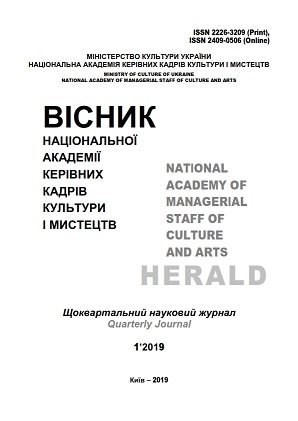Відтворення виразових прийомів мандолiнного iнструменталiзму в творах А.Вівальді та В.А.Моцарта
Clearing of the Expressive Acceptance Mandoline to Instrumental Type in Works of A.Vivaldi and W.Mozart
Author(s): Alexander Leonidovich OliynykSubject(s): Music, 18th Century, History of Art
Published by: Національна академія керівних кадрів культури і мистецтв
Keywords: expressive acceptance mandolin plays; instrumental art of domra and mandolins; style of mandolin expressiveness in sounding to music baroque; style mandolin sounding beside Viennese classicist; music;
Summary/Abstract: The Purpose given studies is an illumination composition and performance-expressive particularities of the works of A.Vivaldi and W.Mozart as that, which supply the influential neoclassical line musics XX century, also style of modern-vanguard of the specified volume of the most Latest time on behalf of followers A.Schänberg and A.Webern as representatives New Wien schools and New music of the past age and contemporaneity. Methodology of the work is intonation approach of the school B.Asafiev in Ukraine with inherent him linguistics- culturology aspect of the interpretation musicology method, with handhold on analyst-structured principle and handhold on comparative stylistic features, hermeneutics-interpretation the foreshortening of the music semiotics " intonation dictionary of the epoch" on Asafiev and further developments in work A.Sokol, E. Markova and others. Scientific novelty of the work reveals itself in that for the first time in Ukrainian musicology is realized musicology analysis of the works for mandolin A.Vivaldi and Mozart - in context of the understanding ties of blood this instrument and aristocratic domra to ukrainian creative everyday life. The Findings. In analyzed Concerto for mandolin A. Vivaldi stands out absence in тематизме mandolins of the melodies of the operatic type or of the recitative- dramatic character that quite often meets in his Violin Concertos. Mandoline themes more gravitate to generalization (and even to archetypes) rhetorical composed that. The chamber coloring of sounding mandolin in works W.Mozart approaches him with the chamber- salon type of musical play of renaissance times. Mozart experience of the use the mandolin marks the way to evolutions of this instrument and domra, as his Ukrainian analog, in XX ct. and in contemporaneity. The last was expressed in typical figurative trend: association to lyrical personalization and coloring type in phone picture.
Journal: Вісник Національної академії керівних кадрів культури і мистецтв
- Issue Year: 2019
- Issue No: 1
- Page Range: 369-373
- Page Count: 5
- Language: Ukrainian

